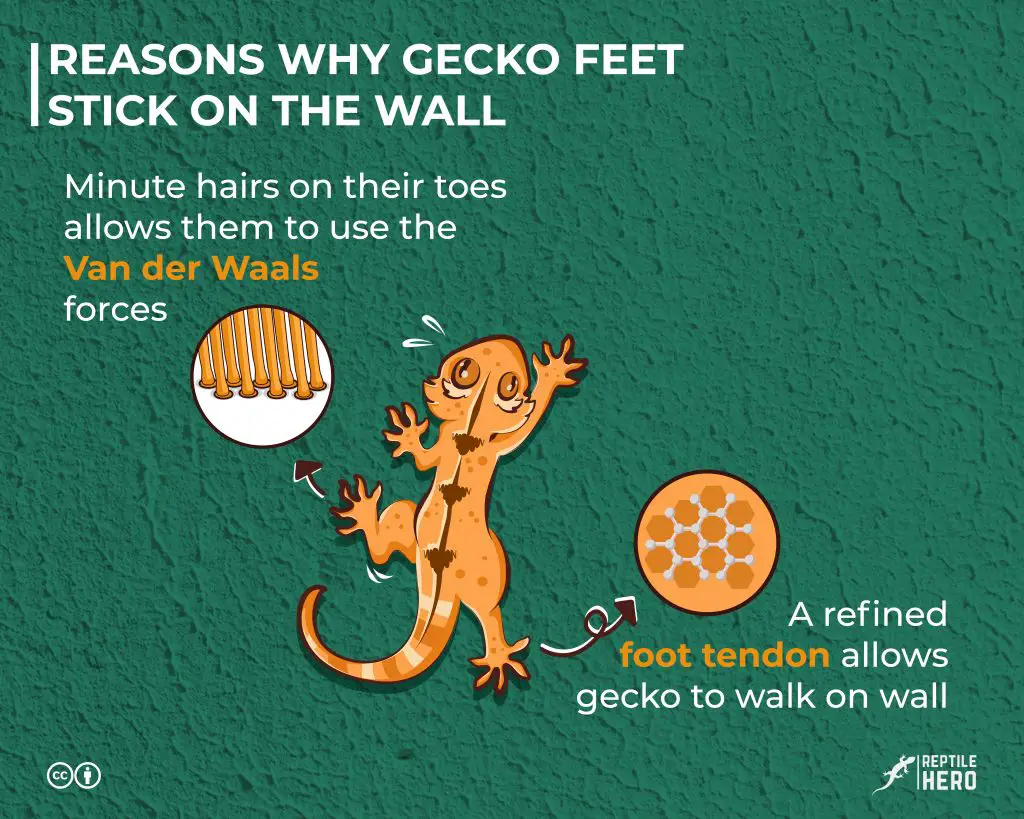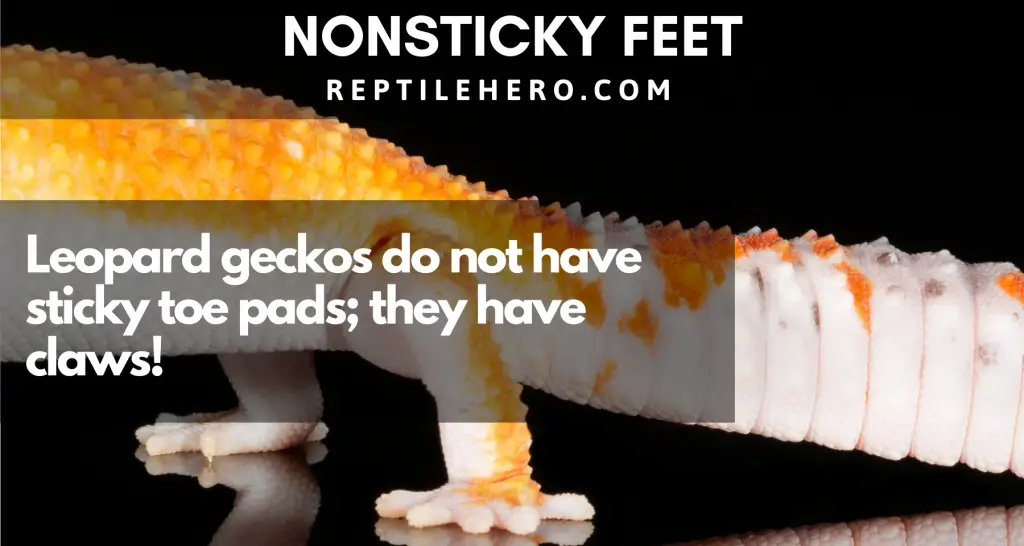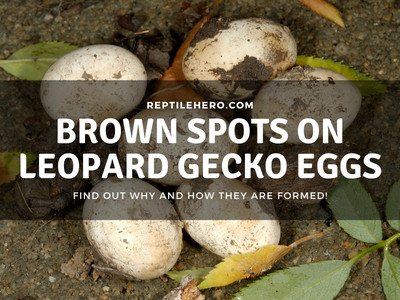How Do Geckos Walk on Walls? [With Science]
Have you seen geckos in the wild or inside caged zoos? What do you notice? They can climb tree trunks, scurry up walls, and walk upside down on ceilings with ease, Spider-Man style! Has it ever crossed your mind, like how it did in mine, how on earth do they pull off these gravity-defying stunts?
Geckos can walk on walls by evolving tiny hairs called setae. These minute hairs found under their toes interact via Van der Waals forces with the surface for an adhesive grip. In addition to this, a refined foot tendon accompanied with rotational walking motion enhances their sticking ability.
Stay with us to know more about the unique walking ability of geckos.

What Makes Geckos Walk on Walls?
Though some people do not find these amazing creatures interesting, I am fascinated by how geckos successfully manage to walk from different angles. It turns out that this distinct ability is because of their feet and a little bit of physical chemistry.
Van der Waals: The Force of Distance
In high school chemistry, Van der Waals was one of the forces discussed; and geckos possess an enormous amount of these weak forces.
For those of you who still remember, you can skip this and jump to the next subheading. However, if you are like one of the ordinary yet curious people, you can continue reading this subheading as I concisely explain more of this topic.
As we all know, atoms bond together to form molecules by use of intramolecular forces (called ionic and covalent bonds). Meanwhile, molecules bound together with one another to create complex molecules make use of intermolecular forces. Both intra and intermolecular forces coexist to hold complex molecules.
You might ask, how do atoms and molecules attract each other? Recall that protons and neutrons form a nucleus with electrons revolving around it. This structure is what we call an atom. Electrons are the key to intermolecular forces since they are primarily responsible for bond formation. By donating and accepting or sharing electrons, atoms form molecules. Because they are not stationary, electrons revolving around the molecule may distort the distribution of charge.
Thus, there are times when a neutral molecule may possess a temporary polarization of charges on both ends—a partially negative charge and a partially positive charge. Temporary polarization of charges can cause neighboring molecules to repel each other once like charges, i.e., negative-negative, come into contact. As a result, they would momentarily crowd at the end away from the negative charge.
Van der Waals forces are collectively a coined term to refer to these weak attractive forces between molecules. Since the nature of the attraction’s strength primarily relies on distance between molecules, the two must come adequately close to each other for the forces to have a considerable effect. This is the force used by geckos all over the world!
But if they were weak, how can geckos utilize these forces to stick on ceilings without falling? The answer lies in the physiology of their feet!
Sticky Toe Pads: The Physiology of Gecko’s Feet
Gecko is one of the reptiles that evolved to scuttle urban walls and rough tree trunks with ease. Unlike their lizard cousins, gecko’s feet are mainly unique to them that even scientists are amazed!
What Is Not Happening?
Before we delve into the main reason why gecko’s feet are so unique, let us first debunk some common misconceptions regarding the matter:
- Secretion: While walking, geckos do not leave behind residues of some sort. Scientists explained that this is because geckos have no glands under their feet for secreting any sticky substance [1].
- Sticking by static electricity: A team of researchers experimented by forming ions around a gecko. If geckos used static electricity, there would have been leaks of electric charge. With the feet still stuck and no leaks found, they abolished this idea.
- Suction: Wolf-Dietrich Dellit demonstrated that gecko’s toes remain stuck even in a vacuum, hence, refuting suction as the mechanism [2].
- Micro-interlocking: Some scientists hypothesized that geckos have hook-like structures under their toes, which latch on to surface irregularities much like Velcro works. With the gecko’s capability of adhering to polished glass, however, they abandoned this mechanism.
What Is Really Happening?
Now that we know that geckos do not use under-toe suction cups or bent hooks. Let us now dive into the real reason why they can walk around pretty much at all angles.
Scientists found out that geckos have a massive number of minute hairs on their pads under their feet, known as seta (plural setae) [3]. These small hairs branch out to even more strands forming little pads at their tips called spatula (plural spatulae).
To give you a perceivable thought on how tiny these branched hairs are, look at your hair and grab one strand. Now imagine a string one-tenth of its diameter! That is how fine the hairs under their feet are. With the extensive branching of these tiny pads, the surface area they can come into intimate contact with the surface the gecko is crawling on drastically increases. As a consequence, Van der Waals forces come into play.
Even though they are deemed trivial, Van der Waals forces integrated within the extensive branching of the tiny pads deploy a relatively pretty strong force as opposed to what is expected.
To have a tangible grip on how strong these forces would become under the gecko’s feet, imagine that the number of hairs covering the area of a single dime can lift an object of up to 45 pounds!
Along with the toe pads and Van der Waals forces, geckos utilize a unique walking technique by exerting a rotational motion to attach and detach their feet from the surface.
By sliding their feet into position, they can assure that the toe pads are sufficiently exposed to produce the required force to stick on the surface.
If they were to straightforwardly place their feet on the surface or pull their legs off the surface, neither would generate enough force to adhere firmly nor combat the immense energy needed to pull off.
Another strategy that geckos incorporate in their walking technique is the speed of their feet. With an astounding rate recorded at 15 times of attaching and detaching per second, this is a feat knowing that they have to sustain such action to adhere. Aside from the revolutionary toe pads, geckos also have foot tendons directly attached to their skin. These specialized tendons automatically stiffen the feet during surface contact, allowing for a more even distribution of forces.
With the strengthened Van der Waals force, immensely branched setae, tweaked foot tendons, and walking strategy, geckos can walk just on any surface you can think of. Hence, this explains the real strength of the gecko feet.
Walkable Surface: Gecko’s Feet Succeed
The breathtaking ability of setae surpasses beyond your imagination. It evolved to become ultra-flexible. For instance, once a gecko jumps from one surface to another, its toe pads must absorb the tremendous amount of energy from the contact and redirect it.
With the setae’s flexibility, redirecting the energy does not become a problem, making it possible for the gecko to walk across any surfaces at almost any angle possible.
Unwalkable Surface: Gecko’s Feet Fail
Despite the impressive feat of the gecko’s toe pads, there are still circumstances where the stickiness could not adhere to a surface.
- Shedding: once a gecko starts shedding its skin, the dead skin cells on the outer surface detach from the integral structure underneath. The new setae beneath the new skin are not yet exposed to any material, resulting in a less efficient sticking ability.
- Moist Surface: water on moist surfaces bonds with the setae on the toe pads. This interaction inhibits the setae to solely link to the surface the gecko adheres to. Aside from this, the wet surface impairs the requisite close contact between the matter and setae.
- Dust: dust on the surface also slips the gecko. The setae would indiscriminately bond with the specks of dust instead of the material it steps on. Thus, it undermines the sticky toe pads from adhering.
- Oil and Soft Materials: oil and soft materials do not lack polarization per se. However, they do not permit strong connections with setae. Hence, the gecko loosens its grip. Soft materials may be likened to a thin leaf on the outside where the gecko would fall once it tries to grip it.
- Nonstick Coatings: nonstick coating materials like TEFLON cripple the sticky feet of geckos. These materials are problematic for the gecko’s clinging ability because they lack the polarization of charges required in Van der Waals forces.
Here is a short clip exhibiting a gecko’s inhibited sticky feet on a TEFLON.
Can All geckos Walk On Surfaces?
Although you may have initially thought that all geckos possess these sticky toe pads, it is sad to say that not all families of geckos have acquired this feature. In numbers, about 40% of the approximately 1,400 gecko species [4] do not have these adhesive pads. Some families included in the list are the Carphodactylidae and Eublepharidae—the family of leopard geckos!
As a result, geckos with evolutionary toe pads can make use of vertical habitats on boulders and treetops where other kinds cannot freely climb. This benefits them by providing more access to food, such as insects and fruits, and by allowing them to avoid predators on the forest floor.

In Comparison: Gecko and Other Lizards
Lizards are known to have adapted to commonly cling on to structures, i.e., walls, rocks, and tree trunks. However, not all lizards developed the same mechanism of achieving this action.
Lizards with Different Mode of Action
For instance, some arboreal lizards evolved to have strong claws for a better grip, such as the common iguana (I. iguana), Chinese water dragon (P. cocincinus), and the massive Komodo dragon (V. komodoensis).
On the other hand, some lizards have developed a prehensile tail for clenching on to aerial supports. That is, they have a tail capable of carrying most of the bodyweight or a tail habitually used to grasp onto things. Some of the lizards having this are Solomon Islands skink (C. zebrata) and the true chameleons from the family Chamaeleonidae.
Lizards with the Same Mode of Action
Meanwhile, other lizards have similarly evolved the adaptive toe pad mechanism of geckos. For example, the family Dactyloidae, commonly known as anoles, and some skins in the family Scincidae have adhesive toes.
In Comparison: Gecko and Other Animals
Evolution in the animal kingdom takes on different paths, depending on the needs of the animal. As for us, humans, we do not yet need those sticky pads Spider-man Style! Perhaps in the future, we could have it? We will never know.
Animals with the Same Mechanism
However, other animals outside the order of lizards have developed similar features found on geckos. As a matter of fact, adhesive toe pads are diversely detected on insects, arachnids, amphibians, and mammals.
- Leaf Beetles (family Chrysomelidae): unlike the ultra-flexible setae of geckos, leaf beetles evolved tiny hairs on their feet that come in various shapes: pointed, flat, and disk-like. Along with the multiple forms, the tiny hairs are arranged in patterns across the feet. Scientists believed that this phenomenon compensates for the varying amount of force needed while moving.
- Spiders (order Araneae): While your naked eyes do not see the thread-like structures around the spiders, their feet are, in fact, covered in thousands of tiny hairs. Like the gecko’s setae, spiders’ small hairs split into even finer triangular-tipped strands called setules. Flexible like setae, setules trigger Van der Waals forces on the surface, allowing spiders to stick on ceilings and walls.
Animals with Different Mechanism
You might ask, how about those animals without setae? How do they climb and adhere to walls? All I can say is that nature works in mysterious ways and allows them to evolve differently.
- Snails (class Gastropoda): to move around on flat surfaces, snails catapult themselves by generating waves of muscular pulses on their feet. These series of muscle contractions and relaxations traverse across the central portion of the foot from tail to head. While moving up a wall or across the ceiling, upside down, they secrete special mucus to provide more friction.
- Tree Frogs (family Rhacophoridae): tree frogs depend on the collaborative efforts of friction and adhesion to stick on vertical surfaces. To increase their grip through friction, they adopt a spread-out stance similar to Spider-Man. In addition to this, they deploy a thin layer of sticky mucus to coat their toe pads in hopes of achieving wet adhesion.
In Comparison: Gecko and Technology

By looking at the sophisticated sticking mechanism of geckos, it is with great ambition that our scientists and engineers could come up with synthetic products by mimicking their intricate clinging ability.
As a matter of fact, you may have read about or heard of some of these nature-inspired adhesive products online or on television ads.
- GeckSkin by the University of Massachusetts Amherst: composed of stiff fabrics with soft elastomers, GeckSkin depends on draping adhesion. As in a natural gecko toe pad, the fabrics are woven into a synthetic tendon to produce a similar effect to that of a gecko’s mechanism.
- Setex GeckoGrip by nanoGriptech: Made from a high friction microfiber surface, Setex GeckoGrip is inspired by the tiny hairs under the toe pads of geckos. It can be customized to a variety of uses, from apparel to mechanical parts.
Takeaways
- Geckos can walk on vertical walls and upside-down on ceilings because of the branched setae under their toes. These tiny hairs interact with the surface by Van der Waals forces.
- While it is generally mistaken that all geckos have this ability, around 40% of the total gecko species lack toe pads and limbs to adhere to walls and vertical surfaces.
- Not all lizards follow the same mechanism as geckos when climbing steep surfaces. Some scuttle using their strong claws while others use their specialized tails as support.
- Though some animals like leaf beetles and spiders have tiny hairs, other arboreal animals resort to different methods like secreting mucus in snails and suction in tree frogs.
- The innovative system of gecko adhesion has inspired human technology like the adhesive and sealants industry.
Sources
[1] http://umich.edu/~hiceweb/projects/nano/Web%20Gecko%20Curriculum%20Part%202.pdf
[2] https://www.ias.ac.in/article/fulltext/secb/013/05/0288-0306
[3] https://pubmed.ncbi.nlm.nih.gov/12198184/
[4] https://phys.org/news/2012-06-sticky-gecko-toes-arose-independently.html

![How Much Electricity Does a Gecko Use? [Full Bill Breakdown]](https://www.reptilehero.com/wp-content/uploads/2021/05/word-image-20-768x576.png)
![Leopard Gecko Morphs 101 [Rarity, Price, and Color]](https://www.reptilehero.com/wp-content/uploads/2021/03/word-image-34-768x576.png)
![What Do Gecko Eggs Look Like? [Size, Color, and More]](https://www.reptilehero.com/wp-content/uploads/2021/03/word-image-25-768x576.png)

![10 Reasons Why Your Gecko Does Not Lay Eggs [with Solutions]](https://www.reptilehero.com/wp-content/uploads/2021/03/Reasons-Why-Gecko-Does-Not-Lay-Egg-Infographic-768x614.jpg)
